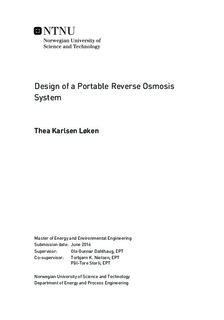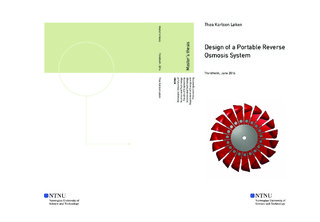| dc.description.abstract | The motivation for this thesis was to design a reverse osmosis system that is small, lightweight, durable and easy to transport. The intended application area of the system is to secure the supply of clean drinking water in remote parts of the world where infrastructure is lacking, or in areas struck by natural disasters. Reverse osmosis is a leading water treatment technology. In a reverse osmosis system, pressurized feedwater is forced through a membrane, and low pressure permeate and high pressure concentrate exits. The energy consumption of the process is a key factor that influences the production cost of the water. By utilizing the energy of the exiting high pressure concentrate, the energy consumption of the process can be significantly reduced.
The primary focus of this thesis was the high pressure pump supplying the feedwater to the system and the energy recovery device utilizing the pressure energy of the exiting concentrate. These components and their influence on the performance of the entire system was to be evaluated by looking at four different solutions. The first solution comprises a high pressure centrifugal pump and a Turgo turbine energy recovery device coupled together on the same shaft. The second solution comprises a high pressure reciprocating pump and a Turgo turbine energy recovery device coupled together on the same shaft. The third solution comprises a high pressure reciprocating pump without any energy recovery device. The fourth and final solution comprises a reciprocating pump with integrated energy recovery. After investigating all four solutions the most practical solution for the given application area was decided, and a prototype of the entire system was constructed using the computer-aided design software Autodesk Inventor.
The most practical solution for the system is believed to be the reciprocating pump with integrated energy recovery. It is believed that the energy savings can be as high as 43 percent when using this solution. The reason for choosing the reciprocating pump over the centrifugal pump is that a reciprocating pump is much better suited for applications of high pressure and low flow rate. The centrifugal pump could not be designed without considerable hydraulic losses. The design of the Turgo turbine was however successful, and it was found that the energy savings by implementing the Turgo turbine as an energy recovery device could be as high as 41 percent. The drawback of the Turgo turbine is that it will increase the size of the system compared to a reciprocating pump with integrated energy recovery. The efficiency of the Turgo turbine will also depend more closely on available head. The reciprocating pump without energy recovery will only reduce the size and complexity of the system slightly, and the recommended solution for the system is therefore the reciprocating pump with integrated energy recovery.
To further validate the assumptions made on the efficiency of the reciprocating pump with integrated energy recovery, a Computational Fluid Dynamics analysis should be performed. Due to time limitations this was however not performed in this master's thesis, and is therefore suggested as further work. | en |

